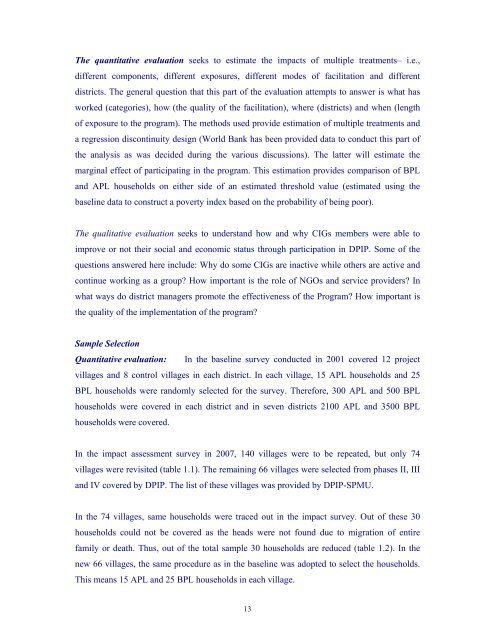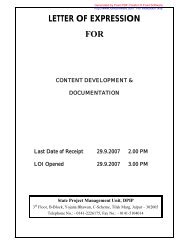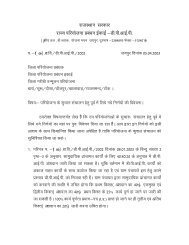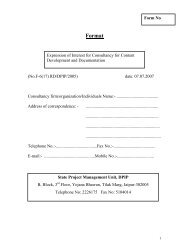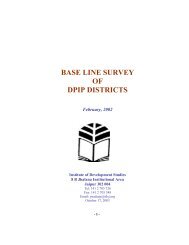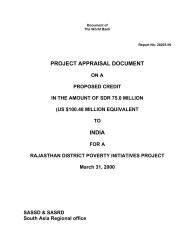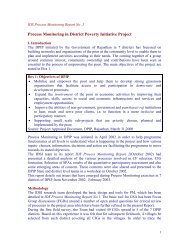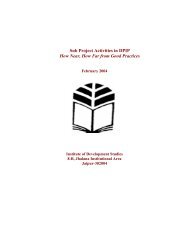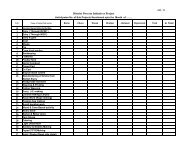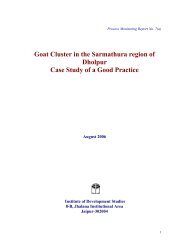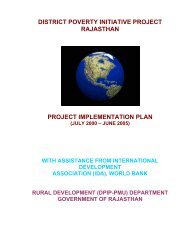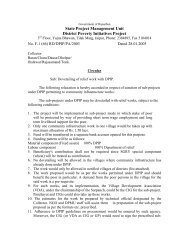Impact Assessment of the District Poverty Initiative Project Rajasthan
Impact Assessment of the District Poverty Initiative Project Rajasthan
Impact Assessment of the District Poverty Initiative Project Rajasthan
You also want an ePaper? Increase the reach of your titles
YUMPU automatically turns print PDFs into web optimized ePapers that Google loves.
The quantitative evaluation seeks to estimate <strong>the</strong> impacts <strong>of</strong> multiple treatments– i.e.,<br />
different components, different exposures, different modes <strong>of</strong> facilitation and different<br />
districts. The general question that this part <strong>of</strong> <strong>the</strong> evaluation attempts to answer is what has<br />
worked (categories), how (<strong>the</strong> quality <strong>of</strong> <strong>the</strong> facilitation), where (districts) and when (length<br />
<strong>of</strong> exposure to <strong>the</strong> program). The methods used provide estimation <strong>of</strong> multiple treatments and<br />
a regression discontinuity design (World Bank has been provided data to conduct this part <strong>of</strong><br />
<strong>the</strong> analysis as was decided during <strong>the</strong> various discussions). The latter will estimate <strong>the</strong><br />
marginal effect <strong>of</strong> participating in <strong>the</strong> program. This estimation provides comparison <strong>of</strong> BPL<br />
and APL households on ei<strong>the</strong>r side <strong>of</strong> an estimated threshold value (estimated using <strong>the</strong><br />
baseline data to construct a poverty index based on <strong>the</strong> probability <strong>of</strong> being poor).<br />
The qualitative evaluation seeks to understand how and why CIGs members were able to<br />
improve or not <strong>the</strong>ir social and economic status through participation in DPIP. Some <strong>of</strong> <strong>the</strong><br />
questions answered here include: Why do some CIGs are inactive while o<strong>the</strong>rs are active and<br />
continue working as a group How important is <strong>the</strong> role <strong>of</strong> NGOs and service providers In<br />
what ways do district managers promote <strong>the</strong> effectiveness <strong>of</strong> <strong>the</strong> Program How important is<br />
<strong>the</strong> quality <strong>of</strong> <strong>the</strong> implementation <strong>of</strong> <strong>the</strong> program<br />
Sample Selection<br />
Quantitative evaluation: In <strong>the</strong> baseline survey conducted in 2001 covered 12 project<br />
villages and 8 control villages in each district. In each village, 15 APL households and 25<br />
BPL households were randomly selected for <strong>the</strong> survey. Therefore, 300 APL and 500 BPL<br />
households were covered in each district and in seven districts 2100 APL and 3500 BPL<br />
households were covered.<br />
In <strong>the</strong> impact assessment survey in 2007, 140 villages were to be repeated, but only 74<br />
villages were revisited (table 1.1). The remaining 66 villages were selected from phases II, III<br />
and IV covered by DPIP. The list <strong>of</strong> <strong>the</strong>se villages was provided by DPIP-SPMU.<br />
In <strong>the</strong> 74 villages, same households were traced out in <strong>the</strong> impact survey. Out <strong>of</strong> <strong>the</strong>se 30<br />
households could not be covered as <strong>the</strong> heads were not found due to migration <strong>of</strong> entire<br />
family or death. Thus, out <strong>of</strong> <strong>the</strong> total sample 30 households are reduced (table 1.2). In <strong>the</strong><br />
new 66 villages, <strong>the</strong> same procedure as in <strong>the</strong> baseline was adopted to select <strong>the</strong> households.<br />
This means 15 APL and 25 BPL households in each village.<br />
13


